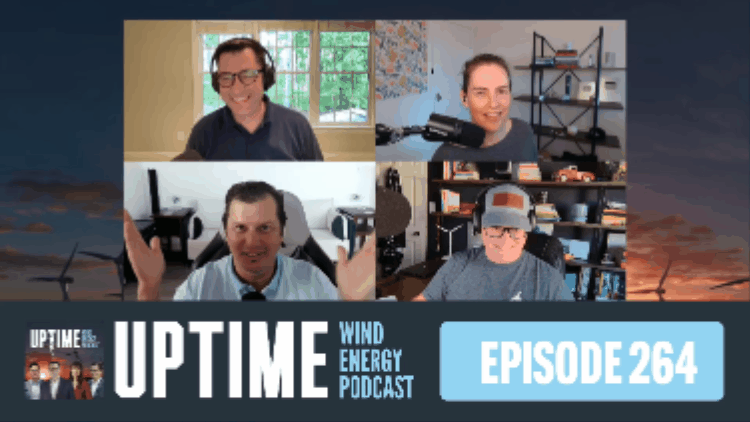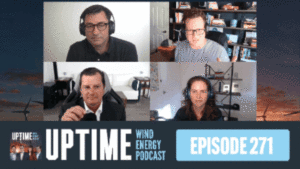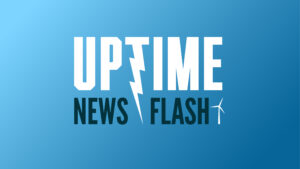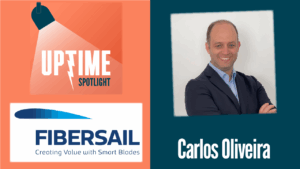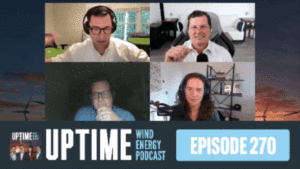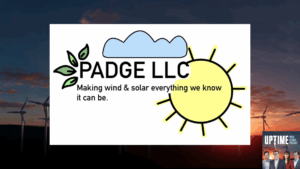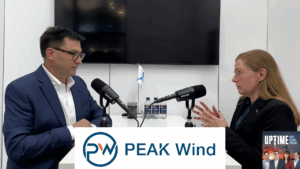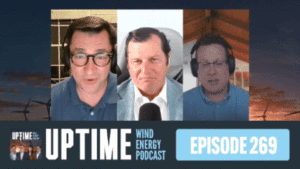Podcast: Play in new window | Download
In this episode, we discuss Ørsted’s new report proposing a 30% reduction in offshore wind energy costs by 2040, and explore the potential role of automation in wind energy manufacturing. Plus a reminder to register for the next SkySpecs webinar, focused on turbine repair trends and best practices. And the La Joya Wind Farm in New Mexico is our wind farm of the week!
Sign up now for Uptime Tech News, our weekly email update on all things wind technology. This episode is sponsored by Weather Guard Lightning Tech. Learn more about Weather Guard’s StrikeTape Wind Turbine LPS retrofit. Follow the show on Facebook, YouTube, Twitter, Linkedin and visit Weather Guard on the web. And subscribe to Rosemary Barnes’ YouTube channel here. Have a question we can answer on the show? Email us!
Speaker: [00:00:00] You are listening to the Uptime Wind Energy Podcast brought to you by build turbines.com. Learn, train, and be a part of the Clean Energy Revolution. Visit build turbines.com today. Now, here’s your host. Allen Hall, Joel Saxon, Phil Totaro, and Rosemary Barnes.
Allen Hall: Well, you won’t want to miss the next SkySpecs webinar, which is on April 30th at 11:00 AM Eastern Time us Which Joel, that’s like, uh, it’s like 5:00 PM Denmark time, right?
Roughly.
Joel Saxum: Mm. Mm-hmm.
Allen Hall: Yeah. And this is the second webinar in the joint series with Uptime and PES Wind. This edition features industry leading repair vendors and discusses the latest trends, challenges, and innovations, shaping the turbine repair landscape. Now this is who schedule to appear. Sheryl Weinstein, principal blade engineer with SkySpecs and.
If anybody knows Sheryl she knows Blades. This is [00:01:00] somebody you want to pay attention to. Alice Lyon, owner and CEO of Lyon technical access. Uh. Really knowledgeable about Blades. Craig Guthrie, who I’ve known for a long time now, director of Blade Service at Takkion and Jose Israel Mejia Rodriguez, who’s director of engineering at RNWBL.
And if you’ve worked with renewable, uh, they do a terrific job keeping turbines up and running. So this discussion will be, uh, talking about best practices for operators and owners and repair teams. But so just, there’s a lot of confusion at times on, on how to. Keep your organization running smoothly.
Well, these experts are gonna be giving you a, a lot of good advice and how to source repair vendors and, and how to evaluate vendors and get certifications and safety records, which are getting more and more critical as the season goes on. So you won’t wanna miss this. April 30th, 11:00 AM Eastern us.
Click the link in the show notes [00:02:00] below to to register for that event and tell a friend, because this is gonna be a, a great webinar. Ørsted has released a significant new report titled Offshore Wind at a Crossroads, and you can go on Google and download this document. It’s, it’s a pretty thick white paper and it examines the current state of the European offshore wind industry.
And Rosemary and I were just over in Copenhagen. We saw. A lot of the offshore wind industry at the Wind Europe event. Now the report focuses on the urgent need to revitalize Europe’s offshore wind industry, and it outlines the policies and industry action required to unlock investment and stabilize some of the costs and accelerate the deployment of offshore wind at.
There are a number of highlights in this. The one of them or two of them, let’s go with the big ones, which is, um, Ørsted proposed a joint commitment between the governments and industry to auction at least 10 gigawatts of CFD capacity over the next 10 years. So [00:03:00] 10 gigawatts per year over the next 10 years, which would be a hundred gigawatts plus another five that would be for c corporate offtake.
So like a PPA, uh, sort of situation. And for doing this, with that commitment, the, the industry would then mobilize investment to try to lower the levelized cost of energy by 30% by 2040. And my first thought was, boy, that’s a pretty good trade off. If, if I’m a. You know, any country in Europe, 30 percent’s a lot because the, the existing CFD prices are in the 90 euros per megawatt hour.
And then we’re gonna try to drop them into the sixties, seventies, uh, by 2040. And, um, my first thought no one was gonna talk to all you today was, is this possible you think they can get a 30% reduction by 2040 in the levelized cost of energy for offshore wind? Some of that coming [00:04:00] from lower cost of access or easier access to cash, which hopefully if interest rates comes down, that will happen.
The other one is just getting better at what they’re doing. Is that something that we can lower the price down that much by 30% by 2040?
Phil Totaro: Well, yeah, they, they target two areas in, in this report that they talk about, uh, reduced cost capital being, you know, 15% of it approximately, and the other 15% being, as you mentioned, like what they’re calling accelerated learning curve.
Um, which is really just, you know, um, what do we used to call that? Economies of scale, uh. You know, effectively, like getting familiar with the manufacturing process around certain things and, and being able to, uh, get cost efficiencies out of, um, you know, uh, wasted, um, manufacturing process or, um. You know, wasted materials and, and things like that as well.
So the [00:05:00] short answer is I don’t know that it’s gonna be 30%, and I, I would actually forecast that the reduced cost of capital will probably be more than 15%. So you may get there, uh, and you know, you might get to 30% reduction just on cost of capital alone, but at the end of the day, yeah, I mean, this isn’t anything revolutionary here.
Um, uh, so. Yeah, it’s, it’s certainly possible to be able to achieve that, especially by a time timeframe like 2040. But we also don’t know what’s gonna happen, uh, you know, in, in the global economic situation between now and then. You know, it’s, that’s 15 years away, 14 years away, and there’s, there’s some black swan event that’s still out there yet to happen that can, you know, throw us into a global recession or, or also into global growth.
So. We’ll see.
Rosemary Barnes: Black Swan is such a weird phrase for an Australian because all swans here are black, and so [00:06:00]
Joel Saxum: the last person that used that with me was an Australian. I think that, I think there’s a couple of things you can think about here though too. If what this is calling for, what this report is calling for is stability within the industry.
We want stability. We want to have more growth. We want to have more opportunity. We want to, we want a market and a power producing industry for off offshore wind that is stable and can drive investment. It can take investment, but if you get to that stage, you’re also gonna bring in more competition.
That’s good. So if it’s a stable space and more people can enter it to, to work in it, then you’re going to more Competition usually drives prices down, whether that’s vessel manufacturers or suppliers or you know, blade repair companies or drone inspections, whatever that may be. More competition usually drops that price and at the same time.
You know, ever since I’ve been in the win industry, it’s been really exciting about how we treat innovation. There’s a lot of people working on a lot of things. And if in the next 15 years innovation, the whole point of innovation is to drive prices down [00:07:00] or to, you know, to save money here, save money there.
So I think that more competition in a stable market, more money coming into innovation in a stable market, um, you know, this is outside of what Phil’s thoughts that are completely correct on, you know, financing coming down and, and cost. I think that those things could drive, uh, an LCOE down, down, down, down, down.
Um. It’s that economy of scale. It’s that once we’re here, we’re ready to roll, we can do these things.
Rosemary Barnes: I might kind of disagree with Joel, but probably at its essence not, not fully disagree. I think that, uh, definitely. I mean, it’s not, it’s not actually a huge reduction over 15 years, right? Like if you look at the previous curves of cost reductions, uh, it’s, you know, it’s, it’s not gonna, it’s not gonna even continue that trend.
But I do think that the recent trend. Up until a couple of years ago, the trend for wind energy’s price reductions was too, too steep, artificially steep, and I think driven by like, excessive competition or like a weird, a weird [00:08:00] kind of competition, um, with maybe too much innovation in a sense. So I think that more of the same of that is, is not the right kind of kind of innovation.
I think what what we need is to have, uh, a few, a few products available. Definitely you need some competition, but. Companies need to be able to make enough enough turbines from the one platform to have a secure pipeline of project. Then you get the kinds of innovation that maybe don’t immediately seem like innovation but aren’t nonetheless, you know, like just little learnings on how to improve cycle times, little learnings on how to improve quality.
You know, just tiny little. Engineering innovations, manufacturing innovations that just have time to build up, have time to repay all of the, you know, like you need a lot of engineering to make a new, a new product, an offshore wind product, reliable and cheap. And you need, uh, enough units made to repay that investment because when you’re just constantly like a new platform, every year we’re [00:09:00] going bigger.
Two years later, we’ve got a bigger wind turbine and two years after that, we’ve got another bigger one. It’s not enough time to make enough wind turbines to repay the engineering investment.
Joel Saxum: And I think Rosemary, I’m, I’m, I’m, I agree with you a hundred percent on that component, and I, where my point was more driven, and I should have said this was more innovation in o and m.
Rosemary Barnes: Yeah,
Joel Saxum: like I’m thinking an operation of wind farms is my, my take on innovation is more innovation in the operations and maintenance. How can we do this better, faster, more efficiently with robotics or whatever that may be. And so that’s where I was going with it, rather than on the development or OEM side.
Allen Hall: But o and m is downstream of OEM. And getting the OEM to deliver a high quality product is the key here. Rosemary, give me a rough estimate on a new development cycle versus continual improvement engineering staff. What is that ratio? Is it 10 to one? When you’re developing a new turbine, you need say, a hundred engineers to sustain it and make it better.
Do you need 10? [00:10:00] You need 20, you need 30. What is that relative number? Because that’s where a lot of savings is gonna happen really is. Reducing the staff and getting more into the manufacturing and focusing there, right?
Rosemary Barnes: Yeah. I mean, it would be a total stab in the dark based on my personal experience.
Probably not totally representative, but it does it, it varies so much from product to product, depending on what kinds of innovations. That you’ve got senior management at engineering companies. Love, love to think that the, you know, like lower level engineers, project managers are just, you know, just like to complain and, um, are too risk averse and all that sort of thing.
But US engineers, you know, back in 20 16, 17, 18, like we, we were right. It was too fast. And the, you know, the, um. Too fast for the amount of engineering support, and we see quality problems now. So I just think like if the industry can’t take another, we will get through this, this crunch now with increased quality problems, increased warranty costs.
We’ll, we’ll, the industry will get through it, but [00:11:00] you can’t have another, another cycle again in five years time from that, you know, like we, you need time to consolidate and rebuild trust in the industry and in the technology. I think in the West we, um, misunderstand what counts as innovation to think it’s only scientists in labs that are, you know, innovating.
It’s only those eureka moments of a new, a new cell chemistry or a new battery chemistry. That’s what counts as innovation. But if you look at the cost reduction, actually. Most cost reduction comes from those like small, boring manufacturing innovations. Um, and not just with manufacturing the project, uh, the product itself, either, you know, um, innovations in terms of.
Uh, you know, installing, installing wind farms, um, and yeah, innovations in, in operating them more effectively can make a huge difference. Innovations in pro, um, in project financing as well can have a, a really big effect. Like Phil mentioned, like the finance cost is one of the easiest or most likely ways that we’ll see cost reductions actually.
So [00:12:00] yeah, we need to broaden our thinking on what kind of innovation that we need. I think
Allen Hall: I wanna take a quick break here, and when I come back I want to understand how. More European supplied components that is obviously gonna happen over the next couple of years, are gonna be able to support this 30% reduction in the LCOE.
Is it possible? Don’t let blade damage catch you off guard the logics Ping sensors detect issues before they become expensive. Time consuming problems. From ice buildup and lightning strikes to pitch misalignment in internal blade cracks. OGs Ping has you covered The cutting edge sensors are easy to install, giving you the power to stop damage before it’s too late.
Visit OGs ping.com and take control of your turbine’s health today. Alright, we’re back. So the dis Rosemary just led a really good discussion about the the ways and methods that LCOE is going to get lowered on offshore wind in Europe. [00:13:00] One of the sticking points I think, though, is there’s gonna be more emphasis on building more components within Europe, which has a higher cost structure.
Can the European manufacturers Vestas, Siemens GAA push down prices if they bring more. Of the components, uh, from Europe, instead of having so many produced in China or in India or wherever they’re gonna be produced at, I, I do feel like there’s gonna be a big push to make some of these things in Europe.
Is that gonna offset the savings are making on the installation and the design improvements? Is there, is there a
Phil Totaro: way to do it, Phil? Potentially, but only with reductions in labor cost. Which, you know, in, you know, we’ve, we’ve talked on the show before about, you know, unionized labor around the world, but I mean, Europe has probably some of the most [00:14:00] heavily regulated, um.
A and, and largest overhead associated with, you know, their, their kind of unionized labor there. Um, so unless they’re going to soften on, on that side of things and find ways to reduce overhead, the short answer is no. The second element of this is raw material costs, which is where we could still leverage.
And, and I’ve talked about this on the show a number of times, we could leverage raw materials from China, raw materials from other places around the world. Um. You know, in exchange for, you know, you know, reductions on tariffs for steel imports, uh, in exchange for more access to, you know, the European market.
Um, and I’ve said that about the United States as well. It’s like, all right, well if the Chinese wanna come over here, they can, but they’ve gotta give us more rare earth elements, uh, you know, to processed rare earth elements. They’ve gotta lift their quotas. So it’s, it’s gotta be something [00:15:00] like that. Um, those would be really the two easiest scenarios to, to get to, um, a production cost in Europe that would be comparable to what people could get in, in India or China.
But without that, I, I don’t see what incentive companies have to re domesticate production.
Allen Hall: Is automation going to play a part in that? Uh, when we were over in, uh, wind Europe, uh, there was a big, uh, celebration between EMAC and Windar. Pivot Mac makes the automated welding machines that are welding really thick steel plate together to make foundations and towers super complicated things, but it’s automated and to, to roll the steel.
Not easy things to do, but it’s automated and it really lowers the cost down and, and making towers when they use these automated tools, these computer controlled tools, is that where the industry’s gonna go? That. We’re gonna see more automation, [00:16:00] more robotics, more um, AI kind of technology thrown at these problems to lower the cost of these parts down?
Rosemary Barnes: I think so. And we’re talking a 15 year timeframe as well. It’s one of the things like with wind industry, that the whole time that I was. Um, looking at a manufacturer, you know, like automation is, um, is coming, is was being introduced to every, every kind of industry. But e everybody in the wind industry was like, oh, we can’t automate wind energy.
We tried and it didn’t work. And that, yeah, we, we, you know, we wasted, I dunno, 10, 10 million euros or whatever on a, a project to automate wind, turbine blade manufacturing. So it won’t happen. And it’s just like, well. Okay, but you know, you tried in 2010 and now we’ve got 2020 technology and Sumar 2000, um, 30 technology and like obviously the whole world is not gonna automate except with the exception of wind energy.
So, um, I think that. There are now, I I also, I did talk to several people at Wind Europe, even from [00:17:00] OEMs that are working on automation projects now. And, um, so we are gonna see either incremental improvements where they just, you know, automate certain parts of the manufacturing process or my personal belief is that we will actually see maybe even a revolution in the way that, uh, a lot of wind turbine components are made to be fully automated and a, a totally different manufacturing process than what we’ve seen.
If that happens, then it, you know, like it goes from being a you, you gotta locate the manufacturing where the, um, labor is cheapest. Then other factors will be more important, like what’s close to the site that you’re installing. ’cause you know, shipping is a large cost, especially for large offshore wind components.
And energy will be a larger cost probably for, you know, automated manufacturing. So low energy costs will be an issue. So I, I do think that we’re. Maybe not five years away, but sometime in the next dec decade. I predict a big, big shake up in the way that, um, the [00:18:00] industry works in terms of manufacturing for wind energy and, and we need it as well.
You know, that’s, that’s something that’s, that’s gotta happen to, to get the cost down to the level that we need them to be, to roll out the amount that we need to have.
Joel Saxum: And when you introduce automation into any kind of industrial process, it, it’s not gonna immediately drop the, the, the end price. A lot of times there’s a, there’s a.
Bit of capital, a bit of NRE that happens with that. Um, and you know, like something nobody wants to go in and start losing or like, as a supplier, nobody wants to go in and then take a lower price point right away. So that price point will remain high when automation is first introduced and what the push is gonna be is gonna, it’s gonna control quality.
You talk about this pema me thing and the windar renewables deal, like there it is so hard to weld as someone who can weld to weld thick, heavy steel together. And to have it be. Perfect or right, or you know, like, that’s so difficult. That is an art meat science thing. And when you can do it in an automated fashion, then your quality goes up.
That’s what we want in the industry. And it’s, and it’s [00:19:00] gonna be a, it’ll be a great snowball. ’cause once we get in there, we get the automation going, quality going, and then after this machine is, you know, basically depreciated, then the, it gets cheaper. Cheaper and cheaper. Cheaper and cheaper as we go. So
Phil Totaro: the, this is the exact, uh, direction we need to go in theoretically.
But I’m gonna, I’m gonna take. Maybe the contrarian approach to this and say what, what normally happens is what Joel just described. You’ve got non-recurring engineering costs and upfront capital costs that usually make something or keep something as expensive or make it even more expensive than it otherwise would be.
Over time. As the, as the, the economies of scale are achieved and the depreciation on the equipment occurs, it’s not like we get a reduction in, in the cost. We just get companies that get bigger margin as a result of, of, you know, leveraging that, that automation and technology. The other point I’ll make is to go back to this, this concept that we, the only reason we haven’t seen.
Uh, you know, [00:20:00] automation more widely adopted today because we have a lot of the, the technologies in place, not all of ’em, you know, we can’t, you still can’t automate like everything, you know, and, and just have a, a factory of robots making wind turbines, but. The reason we haven’t adopted it today is because of the cost of production.
Yes, you might get higher quality, but the cost of production actually wouldn’t be lower than using people power. Uh, and and that’s something that, so just like you get economies of scale with. The components you’re producing, the, the automation itself needs to go through a cost revolution to be able to get down to a price point where it can be more widely adopted, and that’s one of the main reasons why it hasn’t been
Speaker 6: as busy wind energy professionals Staying informed is crucial, and let’s face it difficult.
That’s why the Uptime podcast recommends PES WIN magazine. PES Wind offers a diverse range of in-depth articles and expert [00:21:00] insights that dive into the most pressing issues facing our energy future. Whether you’re an industry veteran or new to wind, PES Wind has the high quality content you need. Don’t miss out.
Visit ps wind.com today.
Allen Hall: Well, if you haven’t downloaded your latest copy of PES Win, you need to do it now by visiting ps win.com. Or, uh, you can actually ask for a hard copy. Hard copy’s brilliant if you can get one. They’re hard to get your hands on lately because there’s, everybody keeps grabbing them at all the trade shows before I can get to them, but.
Hey, what are you gonna do? And in this quarter’s, PES wins a lot of great articles, and one that I knew was coming for a while is from hard head veterans, Joel down in Sweetwater, Texas, and they’ve been developing a helmet safety helmet for wind technicians. And I saw this probably a year ago when the development started and they were head on this project.
This is cool, [00:22:00] uh, neat technology, and so it’s a kevy safety helmet. And it has better protection from both top and side impacts. And the whole goal of this is to have a better, uh, performing better comfort in, especially in Texas where it’s so dang hot. You, you want a helmet that does cool you and, uh.
Hardhead veterans have done that on in numerous industries, but now they’re into wind. This is pretty cool.
Joel Saxum: I think that something that people don’t realize with, uh, safety gear or PPE in general is being a wind turbine technician is very specialized, right? So just like, look, we’re focused on hard hats here, so you’re, you need to be protected from, uh, anything falling from above.
You need to be protective as a we, we call them bump caps, right? So when you’re inside of a n cell or you’re climbing a ladder, whatever, and you bump into something or on the side of the head or the top of the head, you need all that protected. You also need a chin strap because you’re a, we’re the wind [00:23:00] blows.
That’s where we put wind turbines. So you need all these things, but then they’ve gone a step further. And these are some of my favorite components of hard hats in general, and I’ve always said these things. Connected tools, right? So now they’ve got, you’ve got this thing. You can put air protection on it, you can put sunglasses on it.
You can put a headlamp that’s built into it. And my favorite feature, now, this is my, I’m an old school hard hat guy, and I have been, since my oil field days. I like having the brim on the sides to protect my ears from the sun. I hate getting sun, I hate getting sunburnt. And they’ve done like literally everything I like about a hard hat is.
In this hard hat and they’re making ’em in Sweetwater. Uh, I think, uh, this is a fantastic product and these, these guys are gonna see some, some high demand. Hopefully the, the uptime bump helps for their bump caps and then they start making a lot of sales because they look awesome.
Allen Hall: If you go to the website, which is hardhead veterans.com, you can see all the different colors of the kevy hardhat.
They come in all kinds of great colors and I, and I’m sure, is there a requirement, Joel, to have a specific color on site? I know most of ’em are
Joel Saxum: white, but it depends on the operator right, too. Because some of ’em will be like a short [00:24:00] service. Employees need a certain color. Sometimes it’s a, you know, someone who’s a regular technician on the site.
They have a regular color guests. Yeah. Guests have a different color. Yeah. You’re, you’re correct, Phil. Um, so that’s gonna be company by company. But, um, I know that, um, I’m a fan of the old school white hard hat. Keeps it, keeps it cool in the sunlight too.
Allen Hall: Yeah. When Joel and I show up on wind sites, they give it the helmet much with the flashing red light on top to know that we don’t belong there.
Do not let these guys climb a turbine today kinda hat. Yeah. And rightly so. Yeah. So check out uh, PS wind to ps wind.com and also, uh, visit, uh, hardhead veterans, uh, websites. Really cool stuff there.
Rosemary Barnes: Please send me a hard hat with a pod alert logo on it.
Allen Hall: Rosemary has a very special announcement. Go ahead, Rosemary.
Rosemary Barnes: Yeah, my, my little YouTube channel got, uh, passed a hundred thousand subscribers a month or so ago. So now I’ve got my very own, very own play button on display in my background to go with, uh. [00:25:00] Weather Guard won from Asias ago now, year, two years ago, um, and soon to be soon to be joined by a gold version of the button to celebrate 1 million subscribers on the Uptime Wind Energy channel.
Which is a mind blowing number of people around the world who are interested in all the news in wind energy, and which you can find handily combined in one place.
Allen Hall: It’s with Guard Lightning Tech on the YouTube channel. ’cause we, that’s how we started it way back five years ago, is like a little company channel.
We were hoping to get like a thousand people to subscribe at the time and. Now it’s a thousand times
Joel Saxum: that for this week’s Wind farm of the week we’re heading to New Mexico. The La Joa Wind Farm in New Mexico is, uh, owned by Avan Grid, uh, the completed project, which is two phases. We’ll have 111 turbines in it, and they are built now.
So it has 76 ge, 2.8, one 20 sevens, and [00:26:00] 35 Siemens gaa, 2.61 14 uh, meter. Rotor machines. So the project is located about 10 miles west of the village of Encino. Uh, an interesting thing here, which, uh, if you know, if you’ve worked in wind and you know anything about New Mexico, it’s one of the few places in the US that puts wind farms on state.
Owned and public land. So this wind farm is partially on New Mexico land with, uh, 74 turbines at 207 megawatts of that generation on that state land, which, uh, Avan grid won, um, in 2019 through an open bid process, which is a pretty cool, uh, consideration. Uh, so this project will raise over $41 million for New Mexico public schools, which is fantastic.
And one of the things I wanna highlight here is that this, I was looking Wind Farm of the week and I found an article, and this is from 2020 when this wind farm was first being built and it focused on building it during covid and stuff, and [00:27:00] some really cool things they did there. Um, but back then, the, uh, PNM, uh, which is the, the local grid operator there, generation, the, the vice president Tom Ren, said.
When integrated with our wind, solar, and battery storage, p and m is well underway to not only meet state submissions, free mandate, but well positions us on the hundred, the path to a hundred percent carbon free by 2040. So I know that battery storage has been battery storage, battery storage, battery storage last year or so.
But back in 2020, this wind farm and, and when they kicked this thing off, they were talking about it already. So New Mexico, a little bit ahead of the curve there. So, um, the, the Joy of Wind Farm in New Mexico
Allen Hall: by Avangrid, you’re the Wind Farm of the week. That’s gonna do it for this week’s Uptime Wind Energy podcast.
Thanks for listening. Please check out Uptime Tech News, our substack newsletter, which you can find in the show notes below. And check out engineering with Rosie who has reached the 100,000 subscriber stage headed to the millions. We’ll see you here next week on the [00:28:00] Uptime Wind Energy Podcast.



